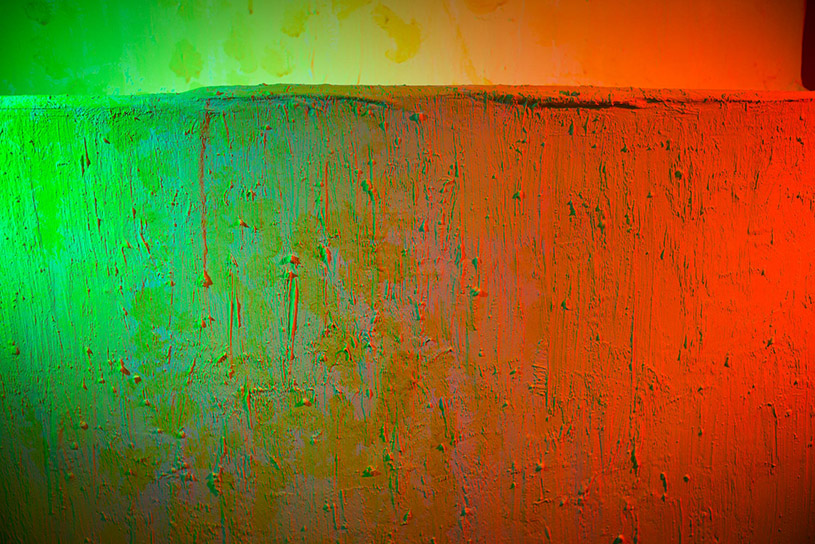
Note: Sevy Perez is the current art director of F Newsmagazine. Photography by Steven Ford.
On Chicago’s north side, just steps from Lake Michigan and far off the beaten arts path, is the Gunder Mansion in Berger Park. In the early 1900s the mansion was the private home of a corporate executive. Now owned by the city of Chicago and preserved as a cultural center, it became the recent site of “Without Sky,” an installation by School of the Art Institute of Chicago (SAIC) graduate student Sevy Perez.
To step inside Perez’s exhibition is to enter into a space constructed of light and time, in which the artist questions awareness and perception through the lens of visible and invisible light. Perez’s art is phenomenological in nature. Phenomenology is the philosophical study of awareness and human experience; it is less concerned with what we know, and more with how we know. Inside “Without Sky” Perez works to bring together science and philosophy with the everyday aspects of human relationships. He uses light and space to draw analogies between our emotional experiences and the scientific ideas that we cannot perceive with the naked eye.

Even with complex scientific ideas at its core, Perez’s installation is both thoughtful and playful. This is particularly expressed in the piece “For Anthony,” in which viewers are confronted by the presence of light that we both can, and cannot, see. It takes form in a series of fluorescent lamps sheathed in gels that transform the blue-white light of the bulbs into hues that exist on the light spectrum, but some color cannot be seen by human eyes.
In astronomy, an occultation occurs when one object is hidden by another object passing between it and the observer. An eclipse is one example. In his piece “Occultation,” Perez covers a fireplace in a mass of plaster and fluorescent paint, then lights it with two colors opposite on the visible light spectrum: blue on the left and red on the right.
“Occultation” is an aggressive act, covering the emotional center of the home, the locust of warmth and quiet comfort. Perez transforms a hearth into an object that vibrates within the eye, reminding the viewer of the sometimes discomfiting dynamics that exist within relationships.

“To Tesseract” is the most intriguing and contradictory piece in the entire installation. This piece, tucked away in a corner, is a small, quiet embodiment of what Perez wrestles with in this show.
Deceptive in its apparent simplicity, “To Tesseract” is a plexiglass cube, roughly 18 inches on each side. It is coated in an opaque varnish that becomes clear only when it is heated to human body temperature. A single light bulb within unveils for the human eye an idea that can only be grasped in abstraction: that of time as a measurement of distance.
We humans exist in a world of three dimensions: height, width, and length. The object Perez presents his viewers with in “To Tesseract” is a model of a tesseract, which represents the fourth dimension: time. The viewer looks in and sees a cube within a cube, floating in a space that cannot exist in our reality. We can only understand it as an abstract mathematical equation, an idea about an idea. It’s something that human language and thought is not capable of describing sufficiently.
However, the piece is titled “To Tesseract” — an action, not a noun. Perez borrows an abstract concept from science to provoke us into stretching our conception of human intimacy. Rather than thinking of our lives as moving in a line from point A to point B, the artist wants us to see that we move through time and space in many directions at once, in an intertwined web of complexity that is possible to talk about only by talking about something else.
“To Tesseract” humbly embodies the entire exhibition in a dialogue on the aspects of intimate relationships that cannot be fully described, but only felt and known through experience. Pressed to explain what we see in another person, we can talk at length about our feelngs, but cherished intimacies will always defy succinct explanation. As soon as we think we’ve succeeded in explaining, we are faced with contradictions and exceptions that rupture the hard-earned definition.
In Without Sky, Perez deftly pulls such aspects of human life and merges them with science. He shows us what we know, but what we often cannot name.
“Without Sky” ran from May 20 to June 13 at the Gunder Mansion.







